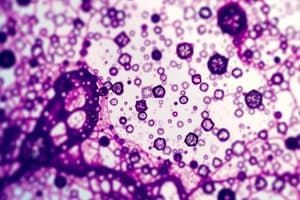Podcast
Questions and Answers
Flashcards
What is fluorescent microscopy?
What is fluorescent microscopy?
The use of ultraviolet rays to illuminate the specimen. It's helpful for studying fluorescent dyes or proteins that emit light when excited by UV rays.
What is orthochromasia?
What is orthochromasia?
The existing structures are colored the same color as the dye itself.
What is metachromasia?
What is metachromasia?
The existing structures are colored differently than the dye itself. The stained structure takes on a different color than the original color of the dye.
What is the purpose of diaminobenzidine in peroxidase immunohistochemistry?
What is the purpose of diaminobenzidine in peroxidase immunohistochemistry?
Signup and view all the flashcards
What is the purpose of fixation?
What is the purpose of fixation?
Signup and view all the flashcards
What is the Sudan stain used for?
What is the Sudan stain used for?
Signup and view all the flashcards
What is liquefactive necrosis?
What is liquefactive necrosis?
Signup and view all the flashcards
What is apoptosis?
What is apoptosis?
Signup and view all the flashcards
What is necrosis?
What is necrosis?
Signup and view all the flashcards
What is hypertrophy?
What is hypertrophy?
Signup and view all the flashcards
What is hyperplasia?
What is hyperplasia?
Signup and view all the flashcards
What is metaplasia?
What is metaplasia?
Signup and view all the flashcards
What is irreversible cellular injury?
What is irreversible cellular injury?
Signup and view all the flashcards
What is coagulation necrosis?
What is coagulation necrosis?
Signup and view all the flashcards
What is fat necrosis?
What is fat necrosis?
Signup and view all the flashcards
What is caseous necrosis?
What is caseous necrosis?
Signup and view all the flashcards
What is apoptosis?
What is apoptosis?
Signup and view all the flashcards
What is fibrinoid necrosis?
What is fibrinoid necrosis?
Signup and view all the flashcards
What is wet gangrene?
What is wet gangrene?
Signup and view all the flashcards
What is dry gangrene?
What is dry gangrene?
Signup and view all the flashcards
What is ischemic necrosis?
What is ischemic necrosis?
Signup and view all the flashcards
What is calcification?
What is calcification?
Signup and view all the flashcards
What is hydropic swelling?
What is hydropic swelling?
Signup and view all the flashcards
What is steatosis?
What is steatosis?
Signup and view all the flashcards
What is amyloidosis?
What is amyloidosis?
Signup and view all the flashcards
What is hemosiderosis?
What is hemosiderosis?
Signup and view all the flashcards
What is hepatocellular icterus?
What is hepatocellular icterus?
Signup and view all the flashcards
What is melanosis?
What is melanosis?
Signup and view all the flashcards
What is an epithelioid cell?
What is an epithelioid cell?
Signup and view all the flashcards
What is a macrophage?
What is a macrophage?
Signup and view all the flashcards
What is a giant cell?
What is a giant cell?
Signup and view all the flashcards
Study Notes
Pathology Study Notes
- Histological Techniques: UV rays are used in fluorescent microscopy.
- Green Trichrome Stain: Erythrocytes stain green.
- Peroxidase Immunohistochemistry Stain: Diaminobenzidine (DAB) is the brown-coloring chemical.
- Histological Techniques: UV rays are used in fluorescent microscopy.
- Green Trichrome Stain: In a green trichrome stain, Erythrocytes stain orange.
- Immunohistochemistry Chemical Name: Diaminobenzidine (DAB) forms the brown color in a peroxidase immunohistochemistry stain.
Studying That Suits You
Use AI to generate personalized quizzes and flashcards to suit your learning preferences.




